County
Acountyis a geographicregionof a country used for administrative or other purposes[1]in some nations. The term is derived from theOld Frenchcomtédenoting a jurisdiction under the sovereignty of acount(earl) or aviscount.[2]Literal equivalents in other languages, derived from the equivalent of "count", are now seldom used officially, includingcomté,contea,contado,comtat,condado,Grafschaft,graafschap,andzhupainSlavic languages;terms equivalent to 'commune' or 'community' are now often instead used.
When theNormansconquered England, they brought the term with them. TheSaxonshad already established the districts that became thehistoric counties of England,calling themshires;[3]many county names derive from the name of the county town (county seat) with the wordshireadded on: for example,GloucestershireandWorcestershire.[4]TheAnglo-Saxontermsearlandearldomwere taken as equivalent to thecontinentalterms "count" and "county" under the conquering Normans, and over time the two blended and became equivalent. Further, the later-imported term became a synonym for the nativeOld Englishwordsċīr([ʃiːr]) or, inModern English,shire– an equivalent administrative division of the kingdom. The term "county" evolved, consequently, to designate a level oflocal administrationthat was immediately beneath anational government,within aunitary(non-federal) system of government. County later also became used differently in somefederal systemsof government, for a local administrative division subordinate to a primarysubnational entity,such as a Province (e.g. Canada) or a level 3 territorial unit such as NUTS 3 (Nomenclature of Territorial Units for Statistics– Level 3).
In the United States and Canada, founded 600 years later[a]on the British traditions, counties are usually an administrative division set by convenient geographical demarcations, which in governance have certain officeholders (for examplesheriffsand theirdepartments) as a part of thestate's andprovince's mechanisms, including geographically common court systems.[5]
A county may be further subdivided into districts,hundreds,townships,or other administrative jurisdictions within the county. A county usually, but not always, contains cities, towns,townships,villages,or othermunicipal corporations,which in most cases are somewhat subordinate or dependent upon county governments. Depending on the nation,municipality,and local geography, municipalities may or may not be subject to direct or indirect county control. The functions of both levels are often consolidated into a city government when the area is densely populated, and are generally not when it is less densely populated.[b]
OutsideEnglish-speaking countries,an equivalent of the termcountyis often used to describe subnational jurisdictions that are structurally equivalent to counties in the relationship they have with their national government;[c]but which may not be administratively equivalent to counties in predominantly English-speaking countries.
Africa
[edit]Kenya
[edit]Counties are the current second-level political division in Kenya. Each county has an assembly where members of the county assembly (MCAs) sit. This assembly is headed by a governor. Each county is also represented in theSenate of Kenyaby a senator. Additionally, a women's representative is elected from each county to theParliament of Kenyato represent women's interests. Counties replacedprovincesas the second-level division after the promulgation of the 2010Constitution of Kenya.
Liberia
[edit]Liberiahas 15 counties, each of which elects two senators to theSenate of Liberia.
Asia
[edit]China
[edit]The English wordcountyis used to translate the Chinese termxiàn(HuyệnorHuyện). InMainland China,governed by thePeople's Republic of China(PRC),countiesandcounty-level divisionsare the third level of regional/local government, coming under theprovincial leveland theprefectural level,and above thetownship levelandvillage level.
There are 1,464 so-named "counties" out of 2,862 county-level divisions in the PRC, and the number of counties has remained more or less constant since theHan dynasty(206 BC – AD 220). It remains one of the oldest titles of local-level government in China and significantly predates the establishment of provinces in theYuan dynasty(1279–1368). The county government was particularly important inimperial Chinabecause this was the lowest level at which the imperial government is functionally involved, while below it the local people are managed predominantly by thegentries.The head of a county government during imperial China was themagistrate,who was often a newly ascendedjinshi.
In older context,districtwas an older English translation ofxiànbefore the establishment of theRepublic of China(ROC). The English nomenclaturecountywas adopted following the establishment of the ROC. In addition,provincial citieshave the same level of authority as counties. Above county, there arespecial municipalities(in effect) and province (suspended due to economical and political reasons). There are currently 13 counties in theROC-controlled territories.
During most of the imperial era, there were no concepts like municipalities in China. All cities existed within counties,commanderies,prefectures, etc., and had no governments of their own.[6]Large cities (must be imperial capitals or seats of prefectures) could be divided and administered by two or three counties. Such counties are called ỷ quách huyện (yǐguō xiàn,'county leaning on the city walls') orPhụ quách huyện(fùguō xiàn,'county attached to the city walls'). Theyamenor governmental houses of these counties exist in the same city. In other words, they share one county town. In this sense, ayǐguō xiànorfùguō xiànis similar to a district of a city.
For example, the city ofGuangzhou(seat of the eponymous prefecture, also known asCantonin the Western world) was historically divided byNanhai County(Nam Hải huyện) andPanyu County(Phiên Ngu huyện). When the first modern city government in China was established in Guangzhou, the urban area was separated from these two counties, with the rural areas left in the remaining parts of them. However, the county governments remained in the city for years, before moving into the respective counties. Similar processes happened in many Chinese cities.
Nowadays, most counties in mainland China, i.e. with "Xian" in their titles, are administered byprefecture-level citiesand have mainly agricultural economies and rural populations.
Indonesia
[edit]Regency (kabupaten) in Indonesia is an administrative unit under a province that is equivalent to a city. A regency is headed by a regent who is directly elected by the people, and is responsible for public services such as education, health, and infrastructure. The structure of a regency includes several districts (kecamatan) which are further divided into several villages. Regency in Indonesia is similar to the concept of "county" in countries such as the United States and the United Kingdom, but with differences in cultural context and government system. Indonesia has more than 400 regencies spread across all provinces.
Iran
[edit]
Theostans(provinces) ofIranare further subdivided into counties calledshahrestān(Persian:شهرستان). County consists of a city centre, a fewbakhsh(Persian:بخش), and many villages around them. There are usually a few cities (Persian:شهر,shahar) and rural agglomerations (Persian:دهستان,dehestān) in each county. Rural agglomerations are a collection of a number of villages. One of the cities of the county is appointed as the capital of the county.
Eachshahrestānhas a government office known asfarmândâri(فرمانداری), which coordinates different events and government offices. Thefarmândârفرماندار,or the head offarmândâri,is the governor of theshahrestān.
Fars Provincehas the highest number ofshahrestāns,with 36, whileQomuniquely has one, beingcoextensivewith itsnamesake county.Iran had 324shahrestānsin 2005 and 443 in 2021.
Korea
[edit]County is the common English translation for thecharacter군(gunorkun) that denotes the current second level political division inSouth Korea.InNorth Korea,the county is one type of municipal-level division.
Europe
[edit]Denmark
[edit]Denmarkwas divided into counties (Danish:amter) from 1662 to 2006. On 1 January 2007 the counties were replaced by fiveRegions.At the same time, the number of municipalities was slashed to 98.
The counties were first introduced in 1662, replacing the 49 fiefs (len) inDenmark–Norwaywith the same number of counties. This number does not include the subdivisions of theDuchy of Schleswig,which was only under partial Danish control. The number of counties in Denmark (excluding Norway) had dropped to around 20 by 1793. Following the reunification ofSouth Jutlandwith Denmark in 1920, four counties replaced thePrussianKreise.AabenraaandSønderborg Countymerged in 1932 andSkanderborgandAarhuswere separated in 1942. From 1942 to 1970, the number stayed at 22.[7]The number was further decreased by the 1970 Danish municipal reform, leaving 14 counties plus two cities unconnected to the county structure;CopenhagenandFrederiksberg.
In 2003,Bornholm Countymerged with the local five municipalities, forming theBornholm Regional Municipality.The remaining 13 counties were abolished on 1 January 2007 where they were replaced by five new regions. In the same reform, the number of municipalities was slashed from 270 to 98 and all municipalities now belong to a region.
France
[edit]
Acomtéwas a territory ruled by acount(comte) in medieval France. In modern France, the rough equivalent of a county as used in many English-speaking countries is adepartment(département). Ninety-six departments are inmetropolitan France,and five areoverseas departments,which are also classified as overseas regions. Departments are further subdivided into 334arrondissements,but these have no autonomy; they are the basis of local organisation of police, fire departments and, sometimes, administration of elections.
Germany
[edit]
Each administrative district consists of an elected council and an executive, and whose duties are comparable to those of a county executive in the United States, supervising local government administration. Historically, counties in theHoly Roman Empirewere calledGrafschaften. The majority of German districts are "rural districts"[8](German:Landkreise), of which there are 294 as of 2017[update].Cities with more than 100,000 inhabitants (and smaller towns in some states) do not usually belong to a district, but take on district responsibilities themselves, similar to the concept ofindependent citiesand there are 107 of them, bringing the total number of districts to 401.[9]
Hungary
[edit]The administrative unit ofHungaryis calledvármegye(between 1950 and 2022 they were calledmegye,historically alsocomitatusinLatin), which can be translated with the wordcounty.The two names are used interchangeably ('megye' used in common parlance, and when referring to the counties of other states), just like before 1950, when the word 'megye' even appeared in legal texts. The 19 counties constitute the highest level of the administrative subdivisions of the country together with the capital city Budapest, although counties and the capital are grouped into seven statistical regions.
Counties are subdivided into districts (járás) and municipalities, the two types of which are towns (város) and villages (község), each one having their own elected mayor and council. 23 of the towns have the rights of a county although they do not form independent territorial units equal to counties.
Thevármegyewas also the historic administrative unit in theKingdom of Hungary,which included areas of present-day neighbouring countries of Hungary. Its Latin name (comitatus) is the equivalent of the Frenchcomté.Actual political and administrative role of counties changed much through history. Originally they were subdivisions of the royal administration, but from the 13th century they became self-governments of the nobles and kept this character until the 19th century when in turn they became modern local governments.
Ireland
[edit]
The island ofIrelandwas historically divided into 32 counties, of which 26 later formed theRepublic of Irelandand 6 made upNorthern Ireland.
These counties are traditionally grouped intofour provinces:Leinster(12 counties),Munster(6),Connacht(5) andUlster(9). Historically, the counties ofMeathandWestmeathand small parts of surrounding counties constituted the province ofMide,which was one of the "Five Fifths" of Ireland (in the Irish language the word for province,cúige,means 'a fifth': fromcúig,'five'); however, these have long since been absorbed into Leinster. In the Republic each county is administered by an elected "county council",and the old provincial divisions are merely traditional names with no political significance.
The number and boundaries of administrative counties in the Republic of Ireland were reformed in the 1990s. For example,County Dublinwas divided into three:Dún Laoghaire–Rathdown,Fingal,andSouth Dublin;theCity of Dublinhad existed for centuries before. The cities ofCorkandGalwayhave been separated from the town and rural areas of their counties. The cities ofLimerickandWaterfordwere merged with their respective counties in 2014. Thus, the Republic of Ireland now has 31 'county-level' authorities, although the borders of the original twenty-six counties are still officially in place.[10]
In Northern Ireland, the six county councils and the smaller town councils were abolished in 1973 and replaced by a single tier of local government. However, in the north as well as in the south, the traditional 32 counties and 4 provinces remain in common usage for many sporting, cultural and other purposes. County identity is heavily reinforced in the local culture by allegiances to county teams inhurlingandGaelic football.EachGaelic Athletic Association countyhas its own flag/colours (and often a nickname), and county allegiances are taken quite seriously. See thecounties of Irelandand theGaelic Athletic Association.
Italy
[edit]InItalythe wordcountyis not used; the administrative sub-division of a region is calledprovincia.Italianprovinces are mainly named after their principal town and comprise several administrative subdivisions calledcomuni('communes'). There are currently 110 provinces in Italy.
In the context of pre-modern Italy, the Italian wordcontadogenerally refers to the countryside surrounding, and controlled by, the city state. Thecontadoprovided natural resources and agricultural products to sustain the urban population. In contemporary usage,contadocan refer to a metropolitan area, and in some cases large rural/suburban regions providing resources to distant cities.[11]
Lithuania
[edit]Apskritis(pluralapskritys) is the Lithuanian word for county. Since 1994Lithuaniahas 10 counties; before 1950 it had 20. The only purpose with the county is an office of a state governor who shall conduct law and order in the county.
Norway
[edit]Norway has been divided into 11counties(Bokmål:fylker,Nynorsk:fylke;singular:fylke) since 2020; they previously numbered 19 following a local government reform in 1972. Until that yearBergenwas a separate county, but today it is amunicipalitywithin the county ofVestland.All counties form administrative entities called county municipalities (fylkeskommunerorfylkeskommunar;singular:fylkeskommune), further subdivided intomunicipalities(kommunerorkommunar;singular:kommune). One county,Oslo,is not divided into municipalities, rather it is equivalent to the municipality of Oslo.
Each county has its owncounty council(fylkesting) whose representatives are elected every four years together with representatives to themunicipal councils.The counties handle matters such as high schools and local roads, and until 1 January 2002 hospitals as well. This last responsibility was transferred to the state-runhealth authoritiesandhealth trusts,and there is a debate on the future of the county municipality as an administrative entity. Some people, and parties, such as theConservativeandProgress Party,call for the abolition of the county municipalities once and for all, while others, including theLabour Party,merely want to merge some of them into larger regions.
Poland
[edit]
The territorial administration of Poland since 1999 has been based on three levels of subdivision. The country is divided intovoivodeships(provinces); these are further divided intopowiats(counties or districts). The termpowiatis often translated into English ascounty(or sometimesdistrict). In historical contexts this may be confusing because the Polish termhrabstwo(a territorial unit administered/owned by ahrabia(count) is also literally translated as "county" and it was subordinated underpowiat.
The 380 county-level entities in Poland include 314 "land counties" (powiaty ziemskie) and the 66 "city counties" (miasta na prawach powiatuorpowiaty grodzkie)powiat.They are subdivisions of the 16voivodeship,and are further subdivided into 2,477gminas(also called commune ormunicipality).[12][13]
Romania
[edit]
The Romanian word for county,comitat,is not currently used for any Romanian administrative divisions. Romania is divided into a total of41 counties(Romanian:județe), which along with themunicipalityofBucharest,constitute the officialadministrative divisions of Romania.They representthe country's NUTS-3 (Nomenclature of Territorial Units for Statistics– Level 3) statistical subdivisions within theEuropean Unionand each of them serves as the local level ofgovernmentwithin its borders. Most counties are named after a majorriver,while some are named after notable cities within them, such as the county seat.
Sweden
[edit]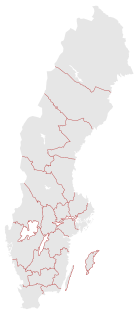
The Swedish division into counties,län,which literally means 'fief', was established in 1634, and was based on an earlier division intoprovinces;Swedenis divided into 21 counties and 290 municipalities (kommuner). At the county level there is acounty administrative boardled by a governor appointed by the centralgovernment of Sweden,as well as an electedcounty councilthat handles a separate set of issues, notablyhospitalsandpublic transportationfor themunicipalitieswithin its borders. The counties and their expanse have changed several times, most recently in 1998.
Every county council corresponds to a county with a number of municipalities per county. County councils and municipalities have different roles and separate responsibilities relating to local government. Health care, public transport and certain cultural institutions are administered by county councils while general education, public water utilities, garbage disposal, elderly care and rescue services are administered by the municipalities.Gotlandis a special case of being a county council with only one municipality and the functions of county council and municipality are performed by the same organisation.[14]
Ukraine
[edit]In Ukraine the county (Ukrainian:повіт,romanized:povit) was introduced in Ukrainian territories under Poland in the second half of the 14th century, and in the eighteenth century under theRussian Empirein theCossack Hetmanate,Sloboda Ukraine,Southern Ukraine,andRight-Bank Ukraine.[15]In 1913 there were 126 counties in Ukrainian-inhabited territories of the Russian Empire.[15]Under theAustrian Empirein 1914 there were 59 counties in Ukrainian-inhabited Galicia, 34 inTranscarpathia,and 10 inBukovina.[15]Counties were retained by the independentUkrainian People's Republicof 1917–1921, and in Czechoslovakia, Poland, and Romania until the Soviet annexations at the start of World War II. 99 counties formed theUkrainian SSRin 1919, where they were abolished in 1923–25 in favour of 53okruhas(in turn replaced byoblastsin 1930–32), although they existed in theZakarpattia Oblastuntil 1953.[15][16]
United Kingdom
[edit]The United Kingdom is divided into a number ofmetropolitan and non-metropolitan counties.There are alsoceremonial countieswhich group small non-metropolitan counties into geographical areas broadly based on thehistoric counties of England.In 1974, the metropolitan and non-metropolitan counties replaced the system ofadministrative countiesandcounty boroughswhich was introduced in 1889. The counties generally belong to level 3 of the Nomenclature of Territorial Units for Statistics (NUTS 3).
In 1965 and 1974–1975, major reorganisations of local government in England and Wales created several new administrative counties such asHereford and Worcester(abolished again in 1998 and reverted, with some transfers of territory, to the two separate historic counties of Herefordshire and Worcestershire) and also created several newmetropolitan countiesbased on large urban areas as a single administrative unit. In Scotland, county-level local government was replaced by largerregions,which lasted until 1996. Modern local government in Scotland, Wales, Northern Ireland and a large part of England is trending towards smaller unitary authorities: a system similar to that proposed in the 1960s by theRedcliffe-Maud Reportfor most of Britain.
The name "county" was introduced by theNormans,and was derived from a Norman term for an area administered by aCount(lord). These Norman "counties" were simply the Saxon shires, and kept their Saxon names. Several traditional counties, includingEssex,SussexandKent,predate the unification of England byAlfred the Great,and were originally more or less independent kingdoms (although the most important Saxon Kingdom on the island of Britain, Alfred's ownWessex,no longer survives in any form).
England
[edit]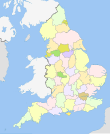
In England, in theAnglo-Saxonperiod,shireswere established as areas used for the raising oftaxes,and usually had a fortified town at their centre. This became known as theshire townor later thecounty town.In many cases, the shires were named after their shire town (for example Bedfordshire), but there are several exceptions, such asCumberland,NorfolkandSuffolk.In several other cases, such asBuckinghamshire,the modern county town is different from the town after which the shire is named. (SeeToponymical list of counties of the United Kingdom)
Most non-metropolitan counties in England are run bycounty councilsand are divided intonon-metropolitan districts,each with its own council. Local authorities in the UK are usually responsible for education, emergency services, planning, transport, social services, and a number of other functions.
Until 1974, the county boundaries of England changed little over time. In themedievalperiod, a number of important cities were granted the status of counties in their own right, such asLondon,BristolandCoventry,and numerous smallexclavessuch asIslandshirewere created. In 1844, most of these exclaves were transferred to their surrounding counties.
Northern Ireland
[edit]
InNorthern Ireland,the six county councils, if not their counties, were abolished in 1973 and replaced by 26 local government districts. The traditional six counties remain in common everyday use for many cultural and other purposes.
Scotland and Wales
[edit]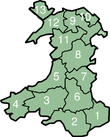
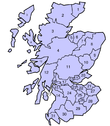
The thirteenhistoric counties of Waleswere fixed by statute in 1539 (although counties such asPembrokeshiredate from 1138) and most of theshires of Scotlandare of at least this age. The Welsh word for county issirwhich is derived from the English 'shire'.[17]The word is officially used to signify counties in Wales.[18]In the Gaelic form, Scottish traditional county names are generally distinguished by the designationsiorramachd—literally "sheriffdom", e.g.Siorramachd Earra-ghaidheal(Argyllshire). This term corresponds to the jurisdiction of the sheriff in the Scottish legal system.
North America
[edit]Canada
[edit]TheprovincesofOntarioandQuebec,and formerlyNova Scotia,have a two-tier system of local government in which counties are upper tier municipalities.
ManitobaandSaskatchewanare divided into rural municipalities. TheNorthwest TerritoriesandNunavutare divided into regions; however, these regions only serve to streamline the delivery of territorial governmental services, and have no government of their own.Newfoundland and Labrador,andYukondo not have any second-level administrative subdivision between the provincial/territorial government and their municipalities.
New Brunswick
[edit]The counties ofNew Brunswickwere upper-tier governance units until the municipal reform of 1967; they were also used as electoral districts until 1973. They remain in use ascensusdivisionsbyStatistics Canadaand by locals as geographic identifiers. The Territorial Division Act defining them remains in effect; their subdivisions are calledparishes.
Ontario
[edit]The primary administrativedivisionofSouthern Ontariois its 22 counties, which are upper-tier local governments providing limited municipal services to rural and moderately dense areas—within them, there are a variety of lower-tier towns, cities, villages, etc. that provide most municipal services. This contrasts with Northern Ontario's 10 districts, which are geographic divisions but not local governments—although some towns, etc. are within them that are local governments, the low population densities and much larger area have significant impacts on how government is organized and operates. In both Northern and Southern Ontario, urban densities in cities are one of two other local structures:regional municipalities(restructured former counties which are also upper tiers) or single-tier municipalities.
Prince Edward Island
[edit]The counties ofPrince Edward Islandare historical and have no governments of their own today. However, they remain used ascensusdivisionsbyStatistics Canada,and by locals as geographic identifiers.
Quebec
[edit]Quebec's counties are more properly called "Regional County Municipalities"(municipalités régionales de comté). The province'sformer countiesproper were supplanted in the early 1980s.
Alberta
[edit]Acountyin Alberta used to be a type of designation in a single-tier municipal system; but this was nominally changed to "municipal district"under theMunicipal Government Act,when theCounty Actwas repealed in the mid-1990s. However, at the time the new "municipal districts" were also permitted to retain the usage ofcountyin their official names.[19]
As a result, inAlberta,the termcountyis synonymous with the termmunicipal district– it is not its own incorporated municipal status that is different from that of a municipal district. As such, Alberta Municipal Affairs provides municipal districts with the opportunity to change to acountyin their official names, but some have chosen to hold out with themunicipal districttitle. The vast majority of "municipal districts" in Alberta are counties.
British Columbia
[edit]British Columbiahascountiesfor the purposes of its justice system but otherwise they hold no governmental function. For the provision of all other governmental services, the province is divided intoregional districtsthat form the upper tier, which are further subdivided intolocal municipalitiesthat are partly autonomous, andunincorporatedelectoral areasthat are governed directly by the regional districts.
Manitoba
[edit]The province ofManitobawas divided intocounties;however, these counties were abolished in 1890.
Jamaica
[edit]Jamaicais divided into 14parisheswhich are grouped together into 3 historiccounties:Cornwall,Middlesex,andSurrey.
United States
[edit]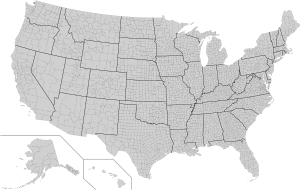
Counties inU.S. statesareadministrativeorpolitical subdivisionsof the state in which their boundaries are drawn. In addition, theUnited States Census Bureauuses the term "county equivalent" to describe places that are comparable to counties, but called by different names.[20]
Forty-eight of the 50 U.S. states use the term "county", while Alaska and Louisiana use the terms "borough"and"parish",respectively, for analogous jurisdictions. Aconsolidated city-county,such as theCity and County of San Francisco,is formed when a city and county merge into one unified jurisdiction. Conversely,independent cities,includingBaltimore,St. Louis,Carson City,and all cities inVirginia,legally belong to no county, i.e. no county even nominally exists in those places compared to a consolidated city-county where a county does legally exist in some form.Washington, D.C.,is known as afederal citybecause it is outside the jurisdiction of any state; the U.S. Census Bureau treats it as a single county equivalent.[20]
The specific governmental powers of counties vary widely between the states. They are generally the intermediate tier of state government, between the statewide tier and the immediately local government tier (typically a city, town/borough, or village/township). Some of the governmental functions that a county may offer include judiciary, county prisons, land registration, enforcement of building codes, and federally mandated services programs. Depending on the individual state, counties or their equivalents may be administratively subdivided intotownships,boroughs or boros,ortowns(in theNew Englandstates,New York,andWisconsin).
New York Cityis a special case where the city is made up offive boroughs,each of which is territorially coterminous with acounty,though not always with an identical name. The Bronx is Bronx County, Brooklyn is Kings County, Manhattan is New York County, Queens is Queens County, and Staten Island is Richmond County. In the context of city government, the boroughs are subdivisions of the city but are still called "county" where county function is involved, e.g., "New York CountyCourthouse ".
County governments inRhode IslandandConnecticuthave been completely abolished but the entities remain for administrative and statistical purposes. Alaska's 323,440-square-mile (837,700 km2)Unorganized Boroughalso has no county equivalent government, but the U.S. Census Bureau further divides it into statistical county equivalent subdivisions calledcensus areas.[20]Massachusettseliminated county governments in 8 of its 14 counties.[21][22]
Today, 3,142 counties and county equivalents carve up the United States, ranging in number from 3 forDelawareto 254 forTexas.The areas of each county also vary widely between the states. For example, the territorially medium-sized state ofPennsylvaniahas 67 counties delineated in geographically convenient ways.[23]By way of contrast,Massachusetts,with far less territory, has massively sized counties in comparison even to Pennsylvania's largest,[d]yet each organizes their judicial and incarceration officials similarly.
Most counties have acounty seat:a city, town, or other named place where its administrative functions are centered. SomeNew Englandstates use the termshire townto mean "county seat". A handful of counties likeHarrison County, Mississippihave two or more county seats, usually located on opposite sides of the county, dating back from the days when travel was difficult. In Virginia, where all cities are independent, some double as county seats despite not being part of a county. Notable examples include the independentCity of Fairfaxserving as the seat ofFairfax CountyandSalemserving as the county seat ofRoanoke County.
Oceania
[edit]Australia
[edit]In theeastern states of Australia,counties areused in the administration of land titles.They do not generally correspond to a level of government, but are used in the identification of parcels of land.
The local communities in Australia that share the samepost codeare usually referred to assuburbs or localities.Several neighboring suburbs are often serviced by the samelocal governmentknown as acouncil,whosejurisdictionis officially known as thelocal government area(LGA). An LGA functions basically the same way as a county of other countries, although it is called instead as "city", "municipality", "shire", "borough", "town", "district" or simple "councils" depending on thestate/territoryandsubregion.It performsmunicipal servicesand regulatespermitsforland uses,but lacks anylegislativeorlaw enforcementpowers.
New Zealand
[edit]After New Zealand abolished itsprovincesin 1876, a system of counties similar to other countries' systems was instituted, lasting until 1989. They had chairmen, not mayors asboroughsand cities had; many legislative provisions (such asburialandland subdivisioncontrol) were different for the counties.
During the second half of the 20th century, many counties received overflow population from nearby cities. The result was often a merger of the two into adistrict(e.g.Rotorua) or a change of name to eitherdistrict(e.g. Waimairi) orcity(e.g.Manukau City).
TheLocal Government Act 1974began the process of bringing urban, mixed, and rural councils into the same legislative framework. Substantial reorganisations under that Act resulted in the 1989 shake-up, which covered the country in (non-overlapping) cities and districts and abolished all the counties except for theChatham IslandsCounty, which survived under that name for a further 6 years but then became a "Territory" under the "Chatham Islands Council".
South America
[edit]Argentina
[edit]Provinces in Argentina are divided intodepartments(Spanish:departamentos), except in theBuenos Aires Province,where they are calledpartidos.TheAutonomous City of Buenos Airesis divided into communes (comunas).
Brazil
[edit]States in Brazil were divided intomicroregions(Portuguese:microrregiões) before they were replaced by "immediate geographic regions" in 2017.
Notes
[edit]- ^1666 in the consolidation of Canada after theFrench and Indian Warfrom the 1066Norman Conquest... 600 yrs
- ^The larger the population center, and the denser the population, the more likely it is to have assumed and subsumed county level functions; normally under a special bill passed by the cognizant legislative body.
- ^National governments that are Federations, such as Germany have subdivisions similar to the English Counties in size. France has regions and departements which similarly provide governmental services. Which services are mapped to which governmental offices, level or officials is the province of the national constitution and legislative body.
- ^e.g. Westmoreland, Washington in western Pennsylvania.
References
[edit]- ^L. Brookes (ed.)Chambers Dictionary.Edinburgh: Chambers Harrap Publishers Ltd, 2005.
- ^C. W. Onions (Ed.)The Oxford Dictionary of English Etymology.Oxford University Press,1966.
- ^Vision of Britain[1]– Type details for ancient county. Retrieved 31 March 2012
- ^"county".Etymology Online.
- ^"County Government".Citizen's Guide to Pennsylvania Local Government:8. 2010.Retrieved9 August2016.
The eleven elected county officers are enumerated in the Pennsylvania Constitution, but their powers and duties are prescribed by statutes located throughout the county codes and general state laws. Consolidation of certain offices in smaller counties involves the offices of prothonotary, clerk of courts, register of wills and recorder of deeds.
- ^There were exceptions in theJīnandYuandynasties, when cities were separated from counties and independently administered by institutions likeLục sự tư(lù shi sī) andTư chờ tư(sī hòu sī).
- ^"Amternes administration 1660–1970 (in Danish)".Dansk Center for Byhistorie. Archived fromthe originalon 4 January 2010.Retrieved1 January2007.
- ^"Country Compendium, A companion to the English Style Guide"(PDF).European Commission Directorate-General for Translation (EC DGT). February 2017. pp. 50–51.Archived(PDF)from the original on 9 October 2022.
- ^"Kreisfreie Städte und Landkreise nach Fläche und Bevölkerung auf Grundlage des ZENSUS 2011 und Bevölkerungsdichte – Gebietsstand: 31.12.2015"(XLS)(in German).Statistisches BundesamtDeutschland. July 2017.Retrieved9 August2017.
- ^"Areas".Ordnance Survey Ireland.Archived fromthe originalon 3 July 2007.Retrieved1 July2007.
- ^Guenzi, Alberto (2016).Guilds, Markets and Work Regulations in Italy, 16th–19th Centuries.Routledge.ISBN9781351931960.
- ^ideo.pl, ideo- (27 April 2019)."Gminy wiejskie chcą lepszej ochrony swych granic".Prawo.pl(in Polish).Retrieved15 February2021.
- ^"Population. Size and structure and vital statistics in Poland by territorial division in 2017. As of December, 31"(PDF)(in Polish). Główny Urząd Statystyczny (Central Statistical Office).Archived(PDF)from the original on 9 October 2022.Retrieved18 August2021.
- ^Swedish Association of Local Authorities and Regions,Municipalities, county councils and regionsArchived22 November 2016 at theWayback Machine;official translation of theLocal Government ActArchived20 February 2005 at theWayback Machine(Kommunallagen);About Stockholm County CouncilArchived21 August 2016 at theWayback Machine
- ^abcd"County".Internet Encyclopedia of Ukraine.Retrieved17 September2022.
- ^"Okruha".Internet Encyclopedia of Ukraine.Retrieved17 September2022.
- ^"Geiriadur Prifysgol Cymru".
- ^"Carmarthenshire County Council Website: Gwefan Cyngor Sir Gaerfyrddin".Carmarthenshire.gov.wales.Retrieved16 March2022.
- ^Province of Alberta."Transitional Provisions, Consequential Amendments, Repeal and Commencement (Municipal Government Act)"(PDF).Archived fromthe original(PDF)on 23 January 2012.Retrieved17 November2010.
- ^abc"County and equivalent entity".factfinder.census.gov.Archived fromthe originalon 22 March 2020.Retrieved21 March2020.
- ^https:// naco.org/sites/default/files/2024-03/2024%20County%20Government%20Primer_v20_FINAL.pdf
- ^https:// test.census.gov/programs-surveys/geography/technical-documentation/county-changes.1970.html
- ^"County Government".Citizen's Guide to Pennsylvania Local Government:8 of 56. 2010.Retrieved9 August2016.
